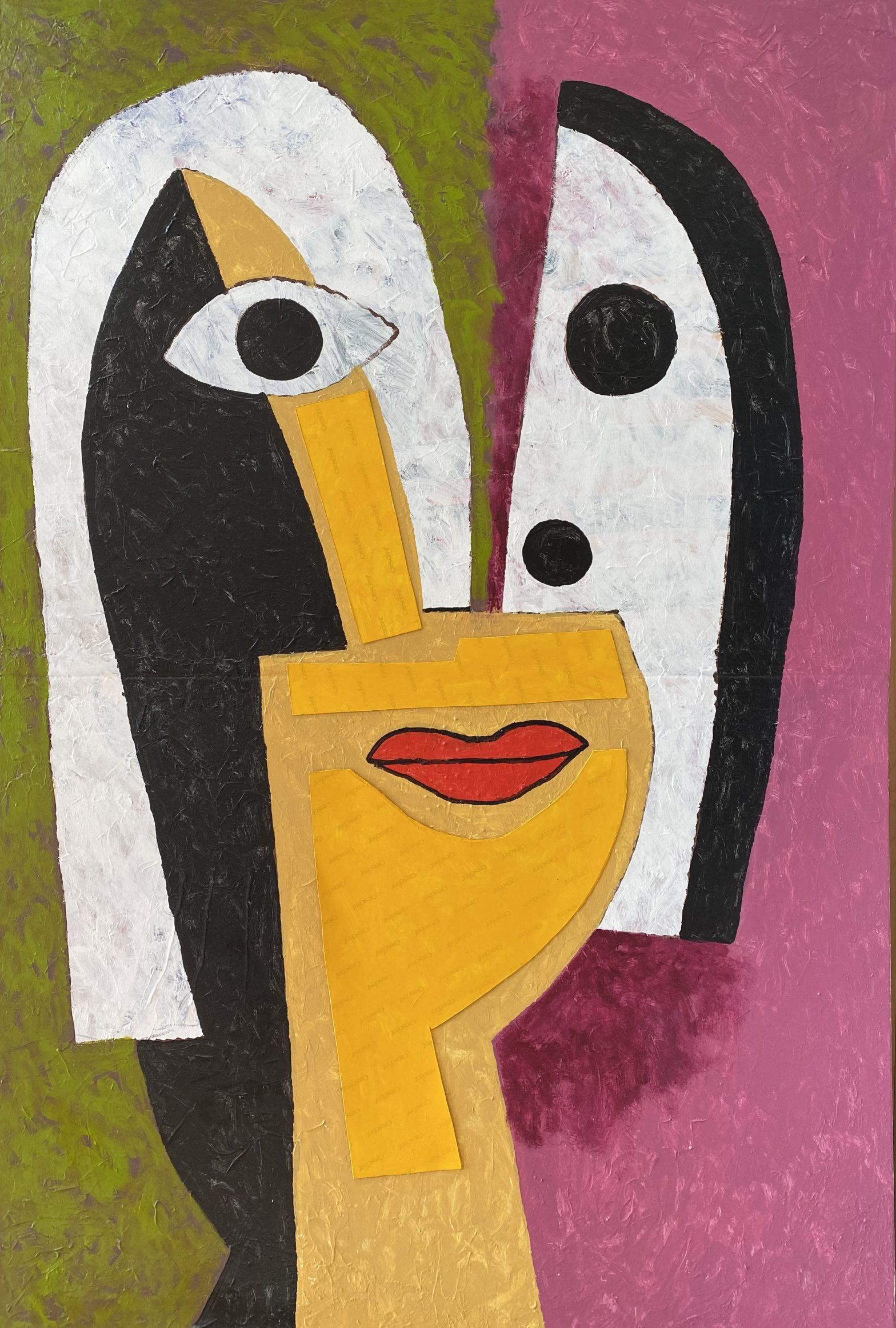By Sarah Sargent
A sense of joy permeates Russ Warren’s “The Disciple” at Les Yeux du Monde. The feeling comes from the jazzy Tex-Mex inflected palette—fiery reds and oranges, slicker yellow and bright turquoise—Warren favors. But it’s also conveyed by the sense of humor, surrealist flourishes, and simple, almost childlike forms that inhabit Warren’s particular brand of figurative abstraction.
Nearly all the work in the exhibition was created over the past two years, and much of it touches on COVID-19. There’s an amusing portrait of an appalled looking Dr. Fauci, mouth agape and surrounded by floating viruses. The subject is serious, but Warren puts his own wry spin on it.
“Deep into August” is another matter. A rare departure in its grim intensity, the triptych was painted when the pandemic was settling in and the future looked pretty bleak. “I was getting really tired of COVID,” Warren says. “I’d thought it would be gone by then, but it was in full force. I was working on each panel individually, sitting outside on a terrace where wrought iron furniture was casting these weird, threatening shadows. It was spooky and intense. The first panel is the pandemic going on, the center one, it’s letting up, and then boom, back to the pandemic.”
By contrast, “Pineapple Ascending” offers hope with its rising symbol of hospitality and welcome, the promise of future interactions with other people.
A Houston native, Warren grew up surrounded by a combination of Mexican influences and cowboy culture. Visiting his father’s office in the Southwest Bank towers as a boy, Warren was dazzled by an enormous mural in the lobby by Mexican artist Rufino Tamayo. “It was the first real art I’d ever seen and it became my idea of what art should be,” he says.
Like any good Texas boy, Warren helped out at his family’s cattle ranch. That legacy is commemorated in a series of works on paper that he has been producing for many years. They feature line drawings of bulls and horses placed against a field of sumptuous color, and Warren titles them by number using Roman numerals, which he places on the animals’ rumps like brands. For the background, he uses liquid acrylic and livestock markers, applied and then scraped away, creating a rich, subtly mottled effect.
“My family used to be a cattle family, in a real small way,” says Warren. “And they used to brand everything. So from the time I was a little boy I was involved and, whoo—the branding was horrific! The Roman numeral brands and the livestock marker are pictorial devices that also reference Texas and this personal history.”
Other artists figure prominently in Warren’s work. He’s co-opted the dots of Picasso and Braque Synthetic Cubism to mute down or heighten a field of color, provide surface variations, or represent things like stars. Warren is also drawn to pattern and texture, working stripes and scumbles into his picture planes. In “Oh Tamayo,” he mixes crushed glass beads into acrylic medium and black pigment to create a lustrous tarry background. The painting includes a collaged newspaper thought bubble in the body of the animal, meant to convey its frustration at not being able to communicate.
“Queen Anne’s Revenge” features a mound of skulls, bones, and other body parts, rendered in bulbous Dubuffet fashion with red and green outlines against a field of black. “‘Queen Anne’s Revenge’ sounds Dylanesque, which being a huge Bob Dylan fan, I like,” says Warren. “It’s an homage to the South Carolina Coast where we go often. Edward Teach, a.k.a Blackbeard, hid out there; Queen Anne’s Revenge was his ship.”
The commanding visage of “The Disciple” is fractured into two distinct expressions. The left side appears alert and interested, while the right is affectless and blank. The two sides meet in the lower part of the face with the slightly pursed lipstick-red mouth. The bold palette pairs a rose and moss green background with black, white, and yellow ochre defining the head. “The disciple is me,” says Warren. “And the mentor was painter Earl Staley.” The two had a friendly yet competitive relationship that Warren feels was important to his development as an artist. “Things kind of went south during the painting process, and the figure switched to become more androgynous. It came together so fast, I never thought it would become one of my favorite paintings.”
A series of small sketches reveal a bit about Warren’s working process and also showcase his line—something you don’t notice in his paintings. “I have different sketch books,” Warren says. “Some are for pen and ink, others for watercolor. I work in one or the other every day. It’s like a third cup of coffee. I’ll go into my studio, do one, let it dry, turn the page and do another. It limbers me up and affects my line and my mark and everything.”
But the joy in the sketches, and that of the paintings, is tempered with the weight of reality—of being human. We get glimpses of this in the memento mori skulls, the specter of COVID, the branding references, the expanses of black that pervade certain works. These things bring an elegiac quality that gives depth and resonance to work that at first seems so simple and so sunny.
